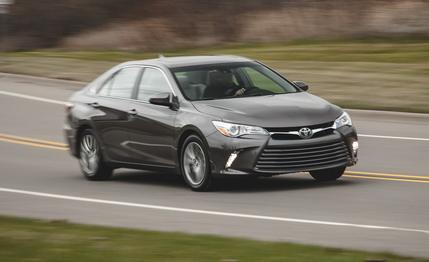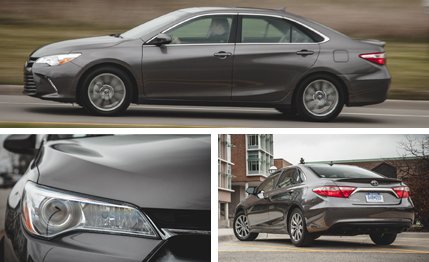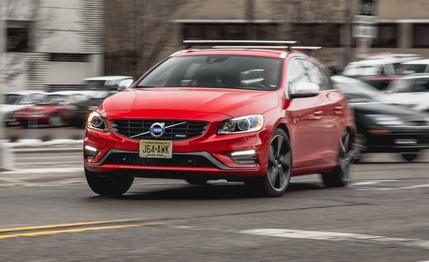
 Instrumented Test
Instrumented Test
America’s bestselling car, the Toyota Camry, is also the car that enthusiasts love to hate. Open disdain for the Camry is a badge of honor on your oil-stained shirtsleeve, a protest against automotive homogeneity. So maybe you’re expecting us to fire off a few cliché synonyms for boring—Vanilla! Beige! Bland!—and get back to our regularly scheduled programming of Corvettes, Mustangs, and Hellcats.
But the 3300-pound punching bag is fighting back against the insults. President Akio Toyoda is a bona fide gearhead, and he’s leading a company-wide crusade to build more exciting cars. We’ve already seen these efforts materialize as the Scion FR-S and the Lexus LFA. But making thrilling rear-drive sports cars is one thing. Using the midcycle refresh of the 2015 Toyota Camry to inject excitement into the front-wheel-drive, family-sedan segment is a much taller task.
Toyota’s mantra for its institutional about-face is waku doki, a phrase so perfectly Japanese-sounding that we expect it to have its own cartoon character. Instead there’s a Toyota-sanctioned dance to help illustrate the meaning: heart-racing characteristics. For the Camry, waku doki is largely an exercise in design. The new face features slimmer headlights, a razorlike grille, and vertical fog lights tucked into gills at the corners. The front visage is in-your-face aggressive, but the side view is entirely innocuous and the rear a bit generic. To us, the overall look is strange rather than heart-racing, made even less exciting since our test car was finished in Predawn Gray Mica over Ash gray leather.


Inside, the Camry is comfortable, with good ergonomics and straightforward controls. The software and the graphics behind the seven-inch touch screen are mediocre, but the physical knobs and buttons for the stereo and climate system are prominent and intuitive. The cabin is roomy and rear-seat space is generous, helped by the fact that the Camry bucks the trend of four-door sedans with coupelike rooflines. Both headroom and legroom are sufficient for a full-grown adult to comfortably ride in back.
Our own interpretation of waku doki would likely translate as a flinty ride and heavy steering to the typical Camry buyer. So it’s no surprise that when it came to tuning the Camry’s chassis, Toyota wisely chose another four years of 400,000 annual sales over a few fawning reviews from automotive fanatics. The Camry XLE drives largely like the Camrys that enthusiasts have come to know and loathe. It’s a bit soft in corners with a thick layer of insulation between the road and the driver. A quiet cabin and a poised ride are the high points. Compared with last year’s model, there are subtle improvements in the weighting of the electrically assisted power steering, and body control is a tad more collected. Overall, though, it’s once again a safe, middle-of-the-road choice, if not our choice. After all, the Camry’s sin was never incompetence; it was always mediocrity. You can do far worse than a Camry, but neither does it threaten the family sedans with verve, the 10Best-winning Honda Accord and Mazda 6.
We should also note that our test car was a loaded, $33,448 XLE, rather than the sporty SE or XSE. Those models employ unique coil springs and shocks, firmer bushings, and a tailored power-steering calibration to sharpen the car’s responses.


Our test car’s 2.5-liter four-cylinder is a holdover from last year’s Camry, with the same 178 horsepower and 170 lb-ft of torque. Its greatest trait is perhaps how unremarkable it is—quiet, smooth, and obedient. If you absolutely must know, it takes 7.9 seconds of matted throttle to hit 60 mph and the quarter-mile floats by in 16.2 seconds. Compared with a 2012 Camry SE with the same engine, the new car is 100 pounds heavier on our scales, a tenth of a second slower to 60 mph, and one tenth quicker through the quarter-mile.
Apparently we used the throttle liberally in our 600 miles with the Camry, because our observed fuel economy of 24 mpg matched that of a 2015 Camry V-6 XSE that we tested simultaneously. If fuel efficiency is at the top of your list of requirements, you’ll want to look at the Camry hybrid, which delivered 31 mpg from its gas-electric powertrain.
Beyond the sheetmetal, there’s not much to get excited about in the latest Camry. It remains a car that is most notable for the pulse-calming character that gives it such broad appeal. Without resorting to beige clichés, we’ll suffice to say that the Camry is every bit the safe play it’s been over the past 13 years as America’s favorite car. Spirited driving dynamics in a family sedan are still in the exclusive domain of the Honda Accord and the Mazda 6. But if Toyota is going to instill some waku doki into this segment with the next redesign, the company is at least on its way. As they say, the first step to recovery is acknowledging you have a problem.